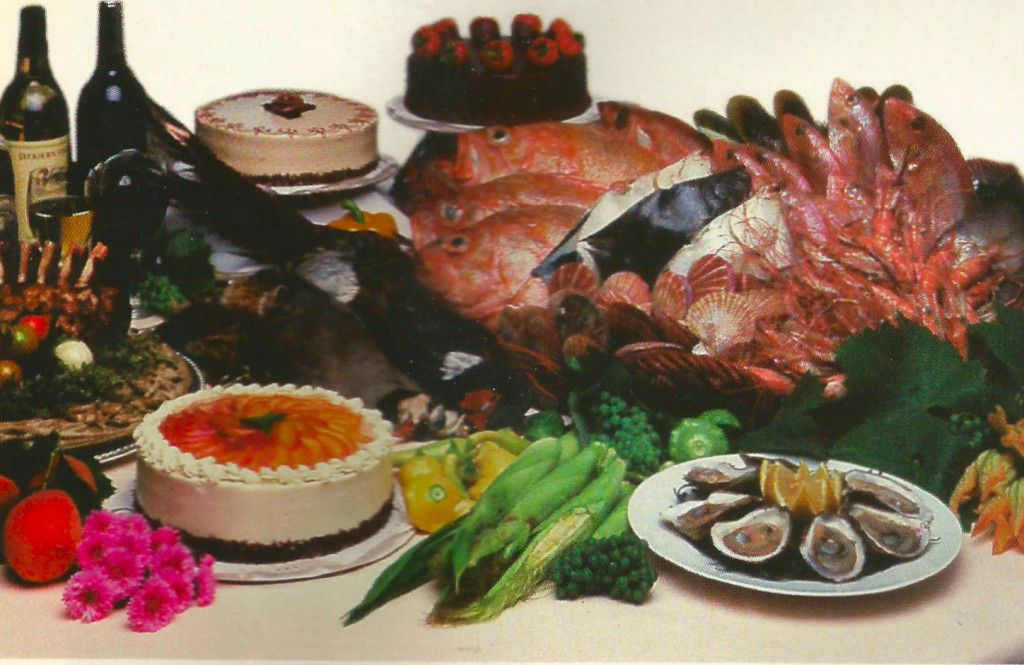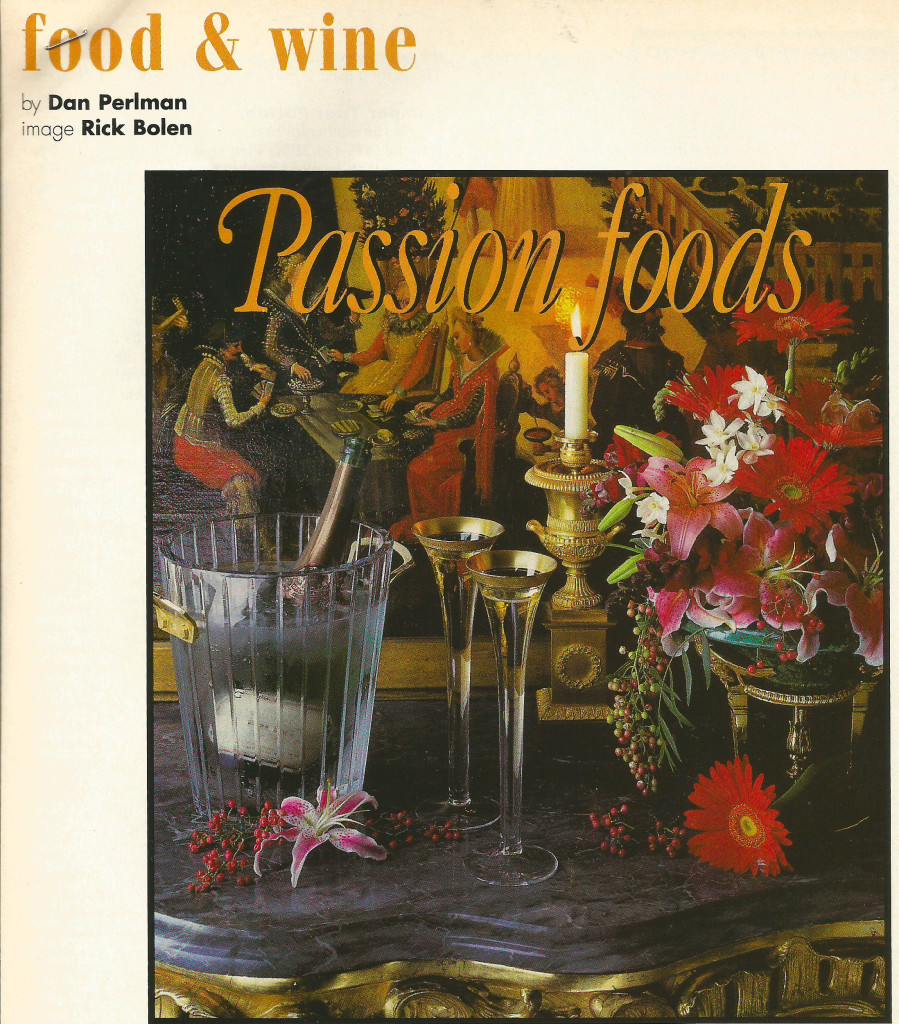Seafood & Wine: The Perfect Combination
July 1999
Pages 54-55
 When I was a trifle younger, during my early days at college, I maintained this fantasy that I would be a marine biologist – the next Jacques Cousteau – traipsing around the world on my boat (the Calypso) and making documentary films about wet guys in speedos who just happened to be surrounded by colorful, tasty fish. Unfortunately, I soon learned that marine biologists tend to be far more interested in how fish dine than in how we dine on fish. While the other students were busy fishing for research grants, I was busy fishing for lunch.
When I was a trifle younger, during my early days at college, I maintained this fantasy that I would be a marine biologist – the next Jacques Cousteau – traipsing around the world on my boat (the Calypso) and making documentary films about wet guys in speedos who just happened to be surrounded by colorful, tasty fish. Unfortunately, I soon learned that marine biologists tend to be far more interested in how fish dine than in how we dine on fish. While the other students were busy fishing for research grants, I was busy fishing for lunch.
This love of fish and shellfish have had a profound influence on my culinary life. I could never be completely vegetarian – never again to flake apart a perfectly roasted sea bass gives me more nightmares than a visit to a cattle feedlot. I also could never keep kosher – the thought of giving up a roasted lobster with drawn butter negates all the points I could earn giving up roast suckling pig. I can’t even consider what it would do to my psyche to pop my next bottle of riesling without a dozen raw oysters at the ready.
England without fish and chips. France without sole meuniere and bouillabaisse. Spain without paella or mariscada. Italy without baccala. All of latin America without ceviche. The U.S. without Mrs. Paul’s. It just won’t do. So there you have it. We’re stuck with seafood. There’s really nothing we can do about it. So tuck that lobster bib in and get your plates ready.
I started going through my menus from the last year to try and pick something to present here, but I quickly became overwhelmed by the choices before me. Lobster souffle with blood orange-wasabi hollandaise; warm sea scallops with heart of palm and white truffle oil; pan-seared butterfish with daikon pudding and mentaiko sauce; pancetta wrapped salmon and tuna roll; salmon, eggplant & sweet basil lasagna; flounder with roasted corn and coconut-lime dressing; cured swordfish with tapenade; red-cooked red snapper with jicama, bamboo & oyster mushrooms; blue-cooked mackeral with root vegetables and tomato-bacon dressing; roasted tuna with peach scales & matsutake ragout; sesame fried soft-shell crabs & grilled spring onions. Where could I even begin?
In anticipation of the many days for love, relaxtion and feasting that this season provides, I decided on a perfect little summer dish.
Salad of Roasted Lobster, Mango, Oscetra Caviar and Cauliflower Cream
4 live lobsters, 1-1½ pounds each
2 mangoes, peeled and diced
1-2 ounces of oscetra caviar
1 small head of cauliflower or one 8 ounce package frozen
1 lime
1 cup of heavy cream
salt
white pepper
mixed edible flowers for garnish
You want your lobster as fresh as possible, so I recommend obtaining them live. Line them up on a sheet pan, put the pan in the oven, turn it on, to 400°F, go outside and have a cocktail to steady your nerves. Roast till done – about 20-25 minutes. They’ll be bright red, and they’ll be cooked.
Let them cool. Remove the tails and claws from the shells, as intact as possible. If any of the lobsters have coral or tamale (the red and green stuff in the main body, respectively, eggs and liver), reserve these to add to the sauce.
Meanwhile, bring a pot of salted water to a boil. If using a fresh cauliflower, break apart into florets. Boil till tender. Take the rind of the lime (just the green, scrape off as much of the white pith as possible) and chop it finely in a food processor. Add the cauliflower florets, and, if there was any, the coral and tamale from the lobsters. Puree. Add the cream a little at a time till you have a consistency similar to mayonnaise. Season to your personal taste with salt, white pepper and approximately 1 teaspoon of the juice from the lime.
Artfully, and now is the time to bring all those hours of watching Martha to bear, arrange the lobster tails (I like to slice it in half inch slices and line them up) and claws on the plate, one lobster per person. Pour sauce, again with all your creative flair, in some pattern on the plate. Scatter the mango dice and flowers here and there. Top with spoonfuls of the caviar. Have another cocktail for your efforts. Eat. Serves four.
Choosing the Right Wine
White wine with fish. Right? Says who? Not that, in general, you’d go wrong with such a match, but let’s face it, whomever first propounded this rule did it just to make it easier to sell white wine. There’s no earthly reason that fish, shellfish, and red wine can’t be perfect bedfellows. Some of the most fish-rich regions of the world have incredible red wines that work perfectly with their local marine cuisine. Sure you might not want a dover sole in lemon butter with a bottle of youthful Côte Rôtie, but you might just want a roasted sea bass bayaldi.
A perfect pairing with the roasted lobster salad is a pinot noir based sparkling wine. My two favorites to serve with this dish are Argyle’s Cuvee Limited Rosé and Schug’s Rouge de Noir, respectively from Oregon and California.
Pinot noir is undoubtedly one of the most fish-friendly reds. Some recent standouts: Whisson Lake Pinot Noir from South Australia, Alain Gueneau Sancerre Rouge from the Loire Valley, and Domaine Saint-Martin Marsanny “Finottes” from Burgundy. Lighter, more elegant styled zinfandels are also a great match for many fish dishes, especially those with spicy accompaniments. Bald Mountain, Rabbit Ridge and Marietta Cellars have some truly wonderful offerings that work brilliantly with seafood.
A few other random choices that I’ve thought paired beautifully with my latest marine biology projects… Paul Bernard Fleurie, a cru Beaujolais, based on the gamay grape; Castel de Paolis “I Quattro Mori”, a blend of syrah, merlot, cabernet and petite verdot; Reignac “Cuvée Spéciale” from Bordeaux, a cabernet based blend; Vega Sindoa “El Chaparral”, an old-vine grenache from Navarra in Spain; any of Bava’s Barbera d’Alba selections; and an unusual, but absolutely delicious wine from California, Terre Rouge Mourvedre.
Q San Francisco magazine premiered in late 1995 as a ultra-slick, ultra-hip gay lifestyle magazine targeted primarily for the San Francisco community. It was launched by my friends Don Tuthill and Robert Adams, respectively the publisher and editor-in-chief, who had owned and run Genre magazine for several years prior. They asked me to come along as the food and wine geek, umm, editor, for this venture as well. In order to devote their time to Passport magazine, their newest venture, they ceased publication of QSF in early 2003.
